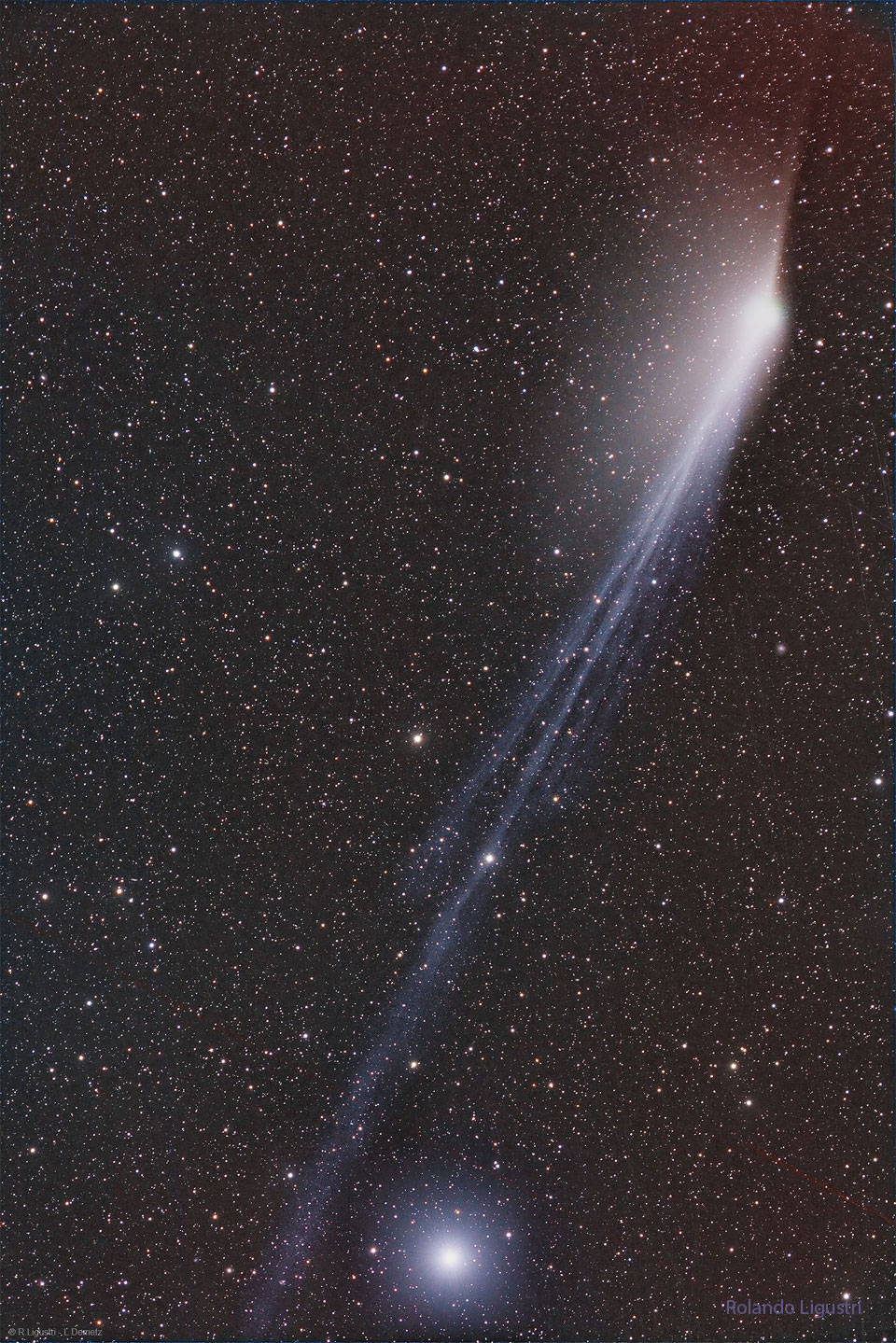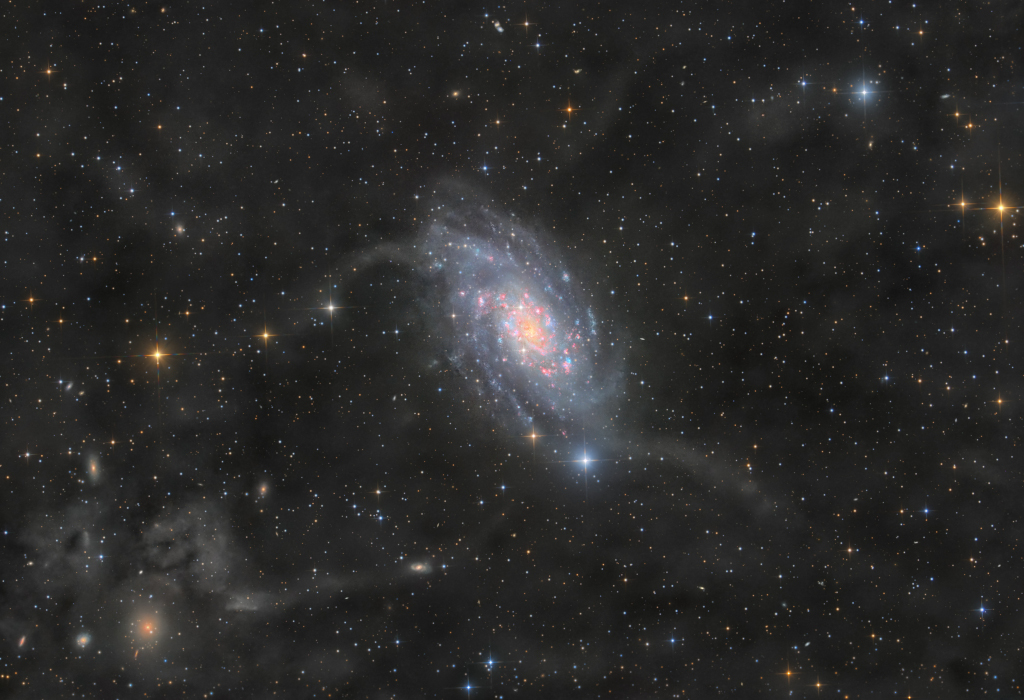Blog




Rhythm Roots Workshop Residency Ecumen Lakeview Commons Assisted Living and Memory Care in Maplewood

The most spectacular tail is the blue-glowing ion tail that is visible flowing down the image. The ion tail is pushed directly out from the Sun by the solar wind. On the upper right is the glowing central coma of Comet 12P/Pons–Brooks. Fanning out from the coma, mostly to the left, is the comet’s dust tail. Pushed out and slowed down by the pressure of sunlight, the dust tail tends to trail the comet along its orbit and, from some viewing angles, can appear opposite to the ion tail. The distant, bright star Alpha Leporis is seen at the bottom of the featured image captured last week from Namibia. Two days ago, the comet passed its closest to the Earth and is now best visible from southern skies as it dims and glides back to the outer Solar System.

Peter Clark Erskine (born June 5, 1954) is an American jazz drummer who was a member of the jazz fusion groups Weather Report and Steps Ahead. Erskine was born in Somers Point, New Jersey, U.S. He began playing the drums at the age of four. He graduated from the Interlochen Arts Academy in Michigan, then studied percussion at Indiana University. His professional music career started in 1972 when he joined the Stan Kenton Orchestra. After four years with Kenton, he joined Maynard Ferguson for two years. In 1978, he joined Weather Report, joining Jaco Pastorius in the rhythm section. After four years and five albums with Weather Report and the Jaco Pastorius big band’s Word of Mouth, he joined Steps Ahead. In 1983, he performed on the Antilles Records release Swingrass ’83. He toured the US in 1992 with Chick Corea.
more...Jerry González (June 5, 1949 – October 1, 2018) was an American bandleader, trumpeter and percussionist of Puerto Rican descent. Geraldo, his father, was a singer in a band and worked for Las Villas, a chain of stores selling Latin American products. Jerry, who liked the trumpet and studied it carefully, but also the congas was a member of Cal Tjader Callen Radcliffe Tjader Jr. an American Jazz musician, known as the most successful non-Latino of Latin Jazz. Together Jerry Gonzalez with his brother, bassist Andy González, played an important role in the development of Latin Jazz during the late 20th century. During the 1970s, both played alongside Eddie Palmieri and in Manny Oquendo‘s Conjunto Libre, and from 1980 to 2018 they directed The Fort Apache Band. From 2000 to 2018, Jerry González resided in Madrid, where he fronted Los Piratas del Flamenco and El Comando de la Clave. In October 2018, he died of a heart attack after a fire in his home in Madrid.
more...Magnificent island universe NGC 2403 stands within the boundaries of the long-necked constellation Camelopardalis. Some 10 million light-years distant and about 50,000 light-years across, the spiral galaxy also seems to have more than its fair share of giant star forming HII regions, marked by the telltale reddish glow of atomic hydrogen gas. The giant HII regions are energized by clusters of hot, massive stars that explode as bright supernovae at the end of their short and furious lives. A member of the M81 group of galaxies, NGC 2403 closely resembles a galaxy in our own local galaxy group with an abundance of star forming regions, M33, the Triangulum Galaxy. Spiky in appearance, bright stars in this portrait of NGC 2403 are in the foreground, within our own Milky Way. Also in the foreground of the deep, wide-field, telescopic image are the Milky Way’s dim and dusty interstellar clouds also known as galactic cirrus or integrated flux nebulae. But faint features that seem to extend from NGC 2403 itself are likely tidal stellar streams drawn out by gravitational interactions with neighboring galaxies.

Michelle Gilliam Phillips (born Holly Michelle Gilliam; June 4, 1944) is an American singer, songwriter and actress. She rose to fame as a vocalist in the musical quartet the Mamas & the Papas in the mid-1960s. Her voice was described by Time magazine as the “purest soprano in pop music”. She later established a successful career as an actress in film and television beginning in the 1970s.
A native of Long Beach, California, she spent her early life in Los Angeles and Mexico City, raised by her widowed father. While working as a model in San Francisco, she met and married John Phillips in 1962 and went on to co-found the vocal group the Mamas & the Papas in 1965. The band rose to fame with their popular singles “California Dreamin’” and “Creeque Alley“, both of which she co-wrote. They released five studio albums before their dissolution in 1970. While married to John Phillips, she gave birth to their daughter, singer Chynna Phillips. Michelle Phillips is the last surviving original member of the band.
After the breakup of the Mamas & the Papas and her divorce from John Phillips, she transitioned into acting, appearing in a supporting part in The Last Movie (1971) before being cast as Billie Frechette in the critically acclaimed crime biopic Dillinger (1973), for which she was nominated for a Golden Globe Awardfor Most Promising Newcomer. In 1974, she had lead roles in two television films: the crime feature The Death Squad, and the teen drama The California Kid, in the latter of which she starred opposite Martin Sheen. She went on to appear in a number of films throughout the remainder of the 1970s, including Ken Russell‘s Valentino (1977), playing Natacha Rambova, and the thriller Bloodline (1979). She released her only solo album, Victim of Romance, in 1977.
Phillips’s first film of the 1980s was the comedy The Man with Bogart’s Face (1980). The next year she co-starred with Tom Skerritt in the nature-themed horror Savage Harvest (1981), followed by the television films Secrets of a Married Man (1984) and The Covenant (1985). In 1987, she joined the series Knots Landing, portraying Anne Matheson, the mother of Paige Matheson (portrayed by Nicollette Sheridan), until the series’s 1993 conclusion.
She later had supporting roles in the comedy film Let It Ride (1989) and the psychological thriller Scissors(1991). In 1998, she was inducted into the Rock and Roll Hall of Fame as a member of the Mamas & the Papas. Phillips appeared in independent films in the 2000s, with supporting parts in Jane White Is Sick and Twisted (2002) and Kids in America (2005) and had recurring guest roles in the television series That’s Life(2001–2002) and 7th Heaven (2001–2004).
more...Michael George Campbell (4 June 1954 – 15 March 2008), better known as Mikey Dread, was a Jamaican singer, producer, and broadcaster. He was one of the most influential performers and innovators in reggae music. Born in Port Antonio, one of five children Campbell showed a natural aptitude for engineering and electronics from an early age. As a teenager he performed with the Safari and Sound of Music sound systems, and worked on his high school’s radio station.
He studied electrical engineering at the College of Arts, Science and Technology, and in 1976, started out as an engineer with the Jamaica Broadcasting Corporation (JBC). Campbell wasn’t impressed that the JBC’s playlists mainly consisted of bland, foreign pop music at a time when some of the most potent reggae was being recorded in Jamaica. He convinced his JBC bosses to give him his own radio program called Dread at the Controls, where he played almost exclusively reggae. Before long, Campbell (now using the DJ name Mikey Dread) had the most popular program on the JBC. Well known for its fun and adventurous sonic style, Dread at the Controls became a hit all over Jamaica. Examples of Mikey Dread’s distinctive radio chatter can be heard on the US release of the RAS label LP African Anthem Dubwise.
more...Freddy Fender (born Baldemar Garza Huerta; June 4, 1937 – October 14, 2006) was an American Tejano singer-songwriter, known for his work as a solo artist and in the groups Los Super Seven and the Texas Tornados. His signature sound fused country, rock, swamp pop and Tex-Mex styles.
Active since the 1950s, when he got his start playing Spanish-language rock and roll for Tejano audiences, Fender’s mainstream breakthrough came in 1975 with the crossover hit “Before the Next Teardrop Falls,” which topped Billboard‘s pop and country charts. He recorded further country hits such as “Wasted Days and Wasted Nights,” “Secret Love,” “You’ll Lose a Good Thing,” “Living It Down,” and “The Rains Came.”Fender was born in San Benito, Texas, United States, to Margarita Garza and her Mexican husband, Serapio Huerta. He made his debut radio performance at age 10 on Harlingen, Texas, radio station KGBT, singing a then-hit “Paloma Querida.
more...Francisco de Jesús Rivera Figueras (born 4 June 1948), known as Paquito D’Rivera, is a Cuban-American alto saxophonist, clarinetist and composer. He was a member of the Cuban songo band Irakereand, since the 1980s, he has established himself as a bandleader in the United States. His smooth saxophone tone and his frequent combination of Latin jazz and classical music have become his trademarks.
Francisco de Jesús Rivera Figueras was born on 4 June 1948 in Havana, Cuba. His father played classical saxophone, entertained his son with Duke Ellington and Benny Goodman records, and he sold musical instruments. He took D’Rivera to clubs like the Tropicana (frequented by his musician friends and customers) and to concert bands and orchestras.
At age five, D’Rivera began saxophone lessons by his father. In 1960, he attended the Havana Conservatory of Music, where he learned saxophone and clarinet and met Chucho Valdés. In 1965, he was a featured soloist with the Cuban National Symphony Orchestra. He and Valdés founded Orchestra Cubana de Música Moderna and then in 1973 the group Irakere, which fused jazz, rock, classical, and Cuban music.
more...Anthony Braxton (born June 4, 1945) is an American experimental composer, educator, music theorist, improviser and multi-instrumentalist who is best known for playing saxophones, particularly the alto.Braxton grew up on the South Side of Chicago, Illinois, and was a key early member of the Association for the Advancement of Creative Musicians. He received great acclaim for his 1969 double–LP record For Alto, the first full-length album of solo saxophone music.
A prolific composer with a vast body of cross-genre work, the MacArthur Fellow and NEA Jazz Masterhas released hundreds of recordings and compositions. During six years signed to Arista Records, the diversity of his output encompassed work with many members of the AACM, including duets with co-founder and first president Muhal Richard Abrams; collaborations with electronic musician Richard Teitelbaum; a saxophone quartet with Julius Hemphill, Oliver Lake and Hamiet Bluiett; compositions for four orchestras; and the ensemble arrangements of Creative Orchestra Music 1976, which was named the 1977 DownBeat Critics’ Poll Album of the Year. Many of his projects are ongoing, such as the Diamond Curtain Wall works, in which Braxton implements audio programming language SuperCollider; the Ghost Trance Music series, inspired by his studies of the Native American Ghost Dance; and Echo Echo Mirror House Music, in which musicians “play” iPods containing the bulk of Braxton’s oeuvre. He has released the first six operas in a series called the Trillium Opera Complex.
Braxton identifies as a “trans-idiomatic” composer and has repeatedly opposed the idea of a rigid dichotomy between improvisation and composition. He has written extensively about the “language music” system that forms the basis for his work and developed a philosophy of “world creativity” in his Tri-Axium Writings.
Braxton taught at Mills College from 1985 to 1990 and was Professor of Music at Wesleyan Universityfrom 1990 until his retirement at the end of 2013. He is the artistic director of the Tri-Centric Foundation, a nonprofit he founded in 1994 to support the preservation and production of works by Braxton and other artists “in pursuit of ‘trans-idiomatic’ creativity”.
more...Oliver Edward Nelson (June 4, 1932 – October 28, 1975) was an American jazz saxophonist, clarinetist, arranger, composer, and bandleader. His 1961 Impulse! album The Blues and the Abstract Truth(1961) is regarded as one of the most significant recordings of its era. The centerpiece of the album is the definitive version of Nelson’s composition, “Stolen Moments“. Other important recordings from the 1960s are the albums More Blues and the Abstract Truth (1964) and Sound Pieces (1966), both also on Impulse!.
Oliver Nelson was born into a musical family in St. Louis, Missouri, United States. His brother was a saxophonist who played with Cootie Williams in the 1940s, and his sister sang and played piano. Nelson began learning to play the piano when he was six and started on the saxophone at the age of 11. Beginning in 1947, he played in “territory” bands in and around Saint Louis, before joining the Louis Jordanband, where he stayed from 1950 to 1951, playing alto saxophone and arranging charts for Jordan’s band.
more...More Posts
- Daily Roots with Bongo Herman & Bingy Bunny
- The Cosmos with NGC 2237
- Jaco Pastorius Day
- Bette Midler Day
- Sandy Nelson Day
- Ike Issacs Day
- World Music with Tamazight
- Daily Roots with Bunny Brown
- Shabbat for the Soul service Mt Zion Temple
- Rhythm Roots Workshop Solo Performance
- The Cosmos with NGC 7552
- Jack Sheldon Day
- Brownie McGhee Day
- Robert Nighthawk Day
- World Music with Paco de Lucia
- Daily Roots with Pat Kelly
- The Cosmos with Corona Australis
- Billy Hart Day
- John Mayall Day
- Billy Strayhorn Day

